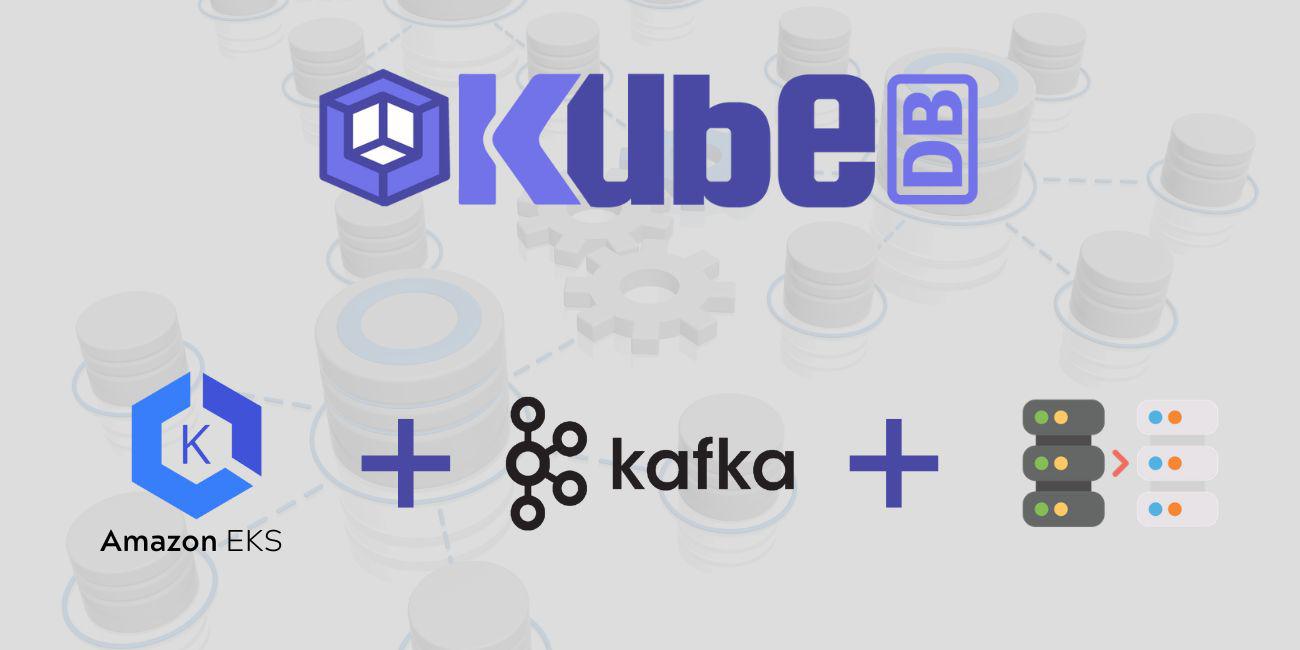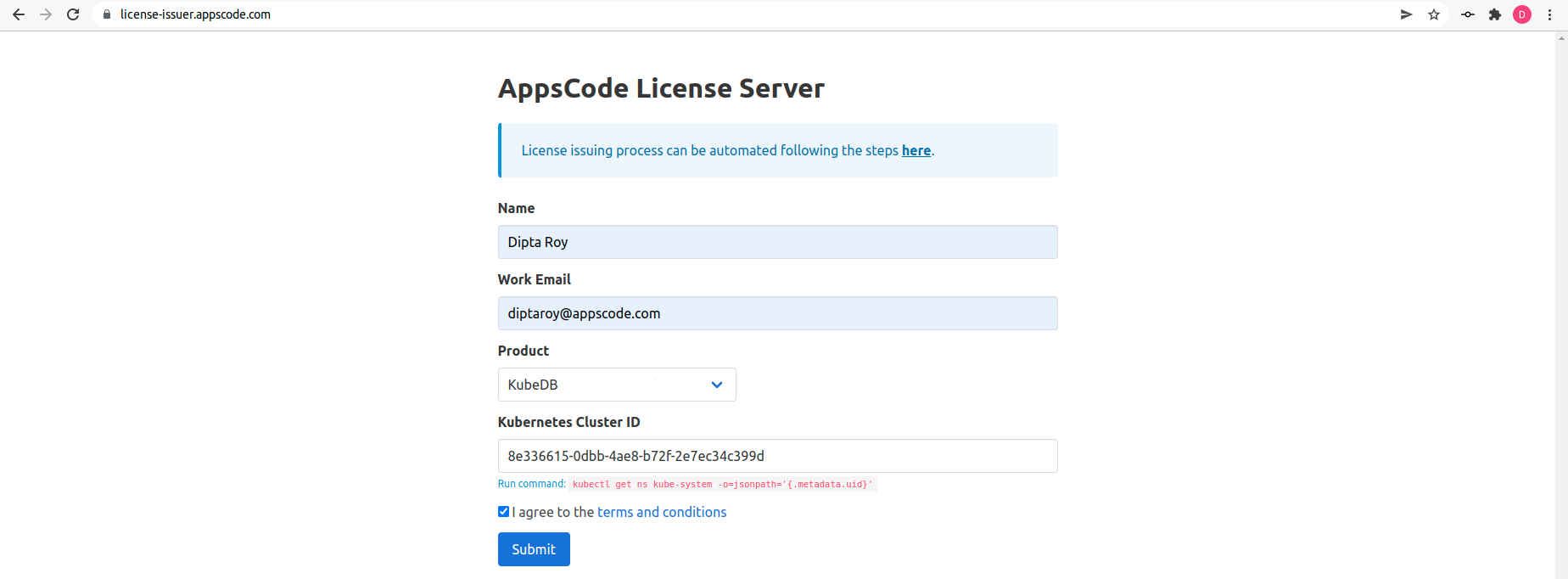
Overview
KubeDB is the Kubernetes Native Database Management Solution which simplifies and automates routine database tasks such as Provisioning, Monitoring, Upgrading, Patching, Scaling, Volume Expansion, Backup, Recovery, Failure detection, and Repair for various popular databases on private and public clouds. The databases supported by KubeDB include MongoDB, Elasticsearch, MySQL, MariaDB, Redis, PostgreSQL, FerretDB, Percona XtraDB, and Memcached. Additionally, KubeDB also supports ProxySQL, PgBouncer and the streaming platform Kafka. You can find the guides to all the supported databases in KubeDB . In this tutorial we will update version of Kafka in Amazon Elastic Kubernetes Service (Amazon EKS). We will cover the following steps:
- Install KubeDB
- Deploy Kafka Cluster
- Publish & Consume Messages with Kafka
- Update Kafka Version
Get Cluster ID
We need the cluster ID to get the KubeDB License. To get cluster ID, we can run the following command:
$ kubectl get ns kube-system -o jsonpath='{.metadata.uid}'
8e336615-0dbb-4ae8-b72f-2e7ec34c399d
Get License
Go to Appscode License Server to get the license.txt file. For this tutorial we will use KubeDB.

Install KubeDB
We will use helm to install KubeDB. Please install helm here
if it is not already installed.
Now, let’s install KubeDB.
$ helm search repo appscode/kubedb
NAME CHART VERSION APP VERSION DESCRIPTION
appscode/kubedb v2024.3.16 v2024.3.16 KubeDB by AppsCode - Production ready databases...
appscode/kubedb-autoscaler v0.29.0 v0.29.0 KubeDB Autoscaler by AppsCode - Autoscale KubeD...
appscode/kubedb-catalog v2024.3.16 v2024.3.16 KubeDB Catalog by AppsCode - Catalog for databa...
appscode/kubedb-community v0.24.2 v0.24.2 KubeDB Community by AppsCode - Community featur...
appscode/kubedb-crd-manager v0.0.8 v0.0.8 KubeDB CRD Manager by AppsCode
appscode/kubedb-crds v2024.3.16 v2024.3.16 KubeDB Custom Resource Definitions
appscode/kubedb-dashboard v0.20.0 v0.20.0 KubeDB Dashboard by AppsCode
appscode/kubedb-enterprise v0.11.2 v0.11.2 KubeDB Enterprise by AppsCode - Enterprise feat...
appscode/kubedb-grafana-dashboards v2024.3.16 v2024.3.16 A Helm chart for kubedb-grafana-dashboards by A...
appscode/kubedb-kubestash-catalog v2024.3.16 v2024.3.16 KubeStash Catalog by AppsCode - Catalog of Kube...
appscode/kubedb-metrics v2024.3.16 v2024.3.16 KubeDB State Metrics
appscode/kubedb-one v2023.12.28 v2023.12.28 KubeDB and Stash by AppsCode - Production ready...
appscode/kubedb-ops-manager v0.31.0 v0.31.0 KubeDB Ops Manager by AppsCode - Enterprise fea...
appscode/kubedb-opscenter v2024.3.16 v2024.3.16 KubeDB Opscenter by AppsCode
appscode/kubedb-provider-aws v2024.3.16 v0.6.0 A Helm chart for KubeDB AWS Provider for Crossp...
appscode/kubedb-provider-azure v2024.3.16 v0.6.0 A Helm chart for KubeDB Azure Provider for Cros...
appscode/kubedb-provider-gcp v2024.3.16 v0.6.0 A Helm chart for KubeDB GCP Provider for Crossp...
appscode/kubedb-provisioner v0.44.0 v0.44.0 KubeDB Provisioner by AppsCode - Community feat...
appscode/kubedb-schema-manager v0.20.0 v0.20.0 KubeDB Schema Manager by AppsCode
appscode/kubedb-ui v2024.2.13 0.6.4 A Helm chart for Kubernetes
appscode/kubedb-ui-server v2021.12.21 v2021.12.21 A Helm chart for kubedb-ui-server by AppsCode
appscode/kubedb-webhook-server v0.20.0 v0.20.0 KubeDB Webhook Server by AppsCode
$ helm install kubedb oci://ghcr.io/appscode-charts/kubedb \
--version v2024.3.16 \
--namespace kubedb --create-namespace \
--set-file global.license=/path/to/the/license.txt \
--wait --burst-limit=10000 --debug
Let’s verify the installation:
$ kubectl get pods --all-namespaces -l "app.kubernetes.io/instance=kubedb"
NAMESPACE NAME READY STATUS RESTARTS AGE
kubedb kubedb-kubedb-autoscaler-65bb97ff8f-h2ct5 1/1 Running 0 4m1s
kubedb kubedb-kubedb-ops-manager-57cd64669f-s4hqw 1/1 Running 0 4m1s
kubedb kubedb-kubedb-provisioner-66f54589cc-q7phb 1/1 Running 0 4m1s
kubedb kubedb-kubedb-webhook-server-5596cd9b99-mhklw 1/1 Running 0 4m1s
kubedb kubedb-petset-operator-5d94b4ddb8-pgnxd 1/1 Running 0 4m1s
kubedb kubedb-petset-webhook-server-75c7fd9c54-gdv4b 2/2 Running 0 4m1s
kubedb kubedb-sidekick-5dc87959b7-8bnlv 1/1 Running 0 4m1s
We can list the CRD Groups that have been registered by the operator by running the following command:
$ kubectl get crd -l app.kubernetes.io/name=kubedb
NAME CREATED AT
connectclusters.kafka.kubedb.com 2024-03-29T05:13:05Z
connectors.kafka.kubedb.com 2024-03-29T05:13:05Z
druidversions.catalog.kubedb.com 2024-03-29T05:12:30Z
elasticsearchautoscalers.autoscaling.kubedb.com 2024-03-29T05:13:02Z
elasticsearchdashboards.elasticsearch.kubedb.com 2024-03-29T05:13:02Z
elasticsearches.kubedb.com 2024-03-29T05:13:02Z
elasticsearchopsrequests.ops.kubedb.com 2024-03-29T05:13:02Z
elasticsearchversions.catalog.kubedb.com 2024-03-29T05:12:30Z
etcdversions.catalog.kubedb.com 2024-03-29T05:12:30Z
ferretdbversions.catalog.kubedb.com 2024-03-29T05:12:30Z
kafkaautoscalers.autoscaling.kubedb.com 2024-03-29T05:13:05Z
kafkaconnectorversions.catalog.kubedb.com 2024-03-29T05:12:30Z
kafkaopsrequests.ops.kubedb.com 2024-03-29T05:13:05Z
kafkas.kubedb.com 2024-03-29T05:13:05Z
kafkaversions.catalog.kubedb.com 2024-03-29T05:12:31Z
mariadbarchivers.archiver.kubedb.com 2024-03-29T05:13:09Z
mariadbautoscalers.autoscaling.kubedb.com 2024-03-29T05:13:08Z
mariadbdatabases.schema.kubedb.com 2024-03-29T05:13:08Z
mariadbopsrequests.ops.kubedb.com 2024-03-29T05:13:08Z
mariadbs.kubedb.com 2024-03-29T05:13:08Z
mariadbversions.catalog.kubedb.com 2024-03-29T05:12:31Z
memcachedversions.catalog.kubedb.com 2024-03-29T05:12:31Z
mongodbarchivers.archiver.kubedb.com 2024-03-29T05:13:12Z
mongodbautoscalers.autoscaling.kubedb.com 2024-03-29T05:13:12Z
mongodbdatabases.schema.kubedb.com 2024-03-29T05:13:12Z
mongodbopsrequests.ops.kubedb.com 2024-03-29T05:13:12Z
mongodbs.kubedb.com 2024-03-29T05:13:12Z
mongodbversions.catalog.kubedb.com 2024-03-29T05:12:31Z
mysqlarchivers.archiver.kubedb.com 2024-03-29T05:13:16Z
mysqlautoscalers.autoscaling.kubedb.com 2024-03-29T05:13:16Z
mysqldatabases.schema.kubedb.com 2024-03-29T05:13:16Z
mysqlopsrequests.ops.kubedb.com 2024-03-29T05:13:16Z
mysqls.kubedb.com 2024-03-29T05:13:16Z
mysqlversions.catalog.kubedb.com 2024-03-29T05:12:31Z
perconaxtradbversions.catalog.kubedb.com 2024-03-29T05:12:31Z
pgbouncerversions.catalog.kubedb.com 2024-03-29T05:12:31Z
pgpoolversions.catalog.kubedb.com 2024-03-29T05:12:31Z
postgresarchivers.archiver.kubedb.com 2024-03-29T05:13:19Z
postgresautoscalers.autoscaling.kubedb.com 2024-03-29T05:13:19Z
postgresdatabases.schema.kubedb.com 2024-03-29T05:13:19Z
postgreses.kubedb.com 2024-03-29T05:13:19Z
postgresopsrequests.ops.kubedb.com 2024-03-29T05:13:19Z
postgresversions.catalog.kubedb.com 2024-03-29T05:12:31Z
proxysqlversions.catalog.kubedb.com 2024-03-29T05:12:31Z
publishers.postgres.kubedb.com 2024-03-29T05:13:19Z
rabbitmqversions.catalog.kubedb.com 2024-03-29T05:12:31Z
redisautoscalers.autoscaling.kubedb.com 2024-03-29T05:13:23Z
redises.kubedb.com 2024-03-29T05:13:23Z
redisopsrequests.ops.kubedb.com 2024-03-29T05:13:23Z
redissentinelautoscalers.autoscaling.kubedb.com 2024-03-29T05:13:23Z
redissentinelopsrequests.ops.kubedb.com 2024-03-29T05:13:23Z
redissentinels.kubedb.com 2024-03-29T05:13:23Z
redisversions.catalog.kubedb.com 2024-03-29T05:12:31Z
singlestoreversions.catalog.kubedb.com 2024-03-29T05:12:31Z
solrversions.catalog.kubedb.com 2024-03-29T05:12:31Z
subscribers.postgres.kubedb.com 2024-03-29T05:13:19Z
zookeeperversions.catalog.kubedb.com 2024-03-29T05:12:31Z
Deploy Kafka Cluster
We are going to Deploy Kafka Cluster by using KubeDB. First, let’s create a Namespace in which we will deploy Kafka.
$ kubectl create namespace demo
namespace/demo created
Here is the yaml of the Kafka CR we are going to use:
apiVersion: kubedb.com/v1alpha2
kind: Kafka
metadata:
name: kafka-cluster
namespace: demo
spec:
replicas: 3
version: 3.3.2
storage:
accessModes:
- ReadWriteOnce
resources:
requests:
storage: 1Gi
storageClassName: gp2
storageType: Durable
terminationPolicy: WipeOut
Let’s save this yaml configuration into kafka-cluster.yaml
Then create the above Kafka CR
$ kubectl apply -f kafka-cluster.yaml
kafka.kubedb.com/kafka-cluster created
In this yaml,
spec.versionfield specifies the version of Kafka. Here, we are using Kafka3.3.2. You can list the KubeDB supported versions of Kafka by running$ kubectl get kafkaversionscommand.spec.storage.storageClassNameis the name of the StorageClass used to provision PVCs.spec.terminationPolicyfield is Wipeout means it will be deleted without restrictions. It can also be “Halt”, “Delete” and “DoNotTerminate”. Learn More about these checkout Termination Policy .
Once these are handled correctly and the Kafka object is deployed, you will see that the following objects are created:
$ kubectl get all,secret -n demo -l 'app.kubernetes.io/instance=kafka-cluster'
NAME READY STATUS RESTARTS AGE
pod/kafka-cluster-0 1/1 Running 0 2m32s
pod/kafka-cluster-1 1/1 Running 0 87s
pod/kafka-cluster-2 1/1 Running 0 81s
NAME TYPE CLUSTER-IP EXTERNAL-IP PORT(S) AGE
service/kafka-cluster-pods ClusterIP None <none> 9092/TCP,9093/TCP,29092/TCP 2m33s
NAME READY AGE
statefulset.apps/kafka-cluster 3/3 2m32s
NAME TYPE VERSION AGE
appbinding.appcatalog.appscode.com/kafka-cluster kubedb.com/kafka 3.3.2 2m32s
NAME TYPE DATA AGE
secret/kafka-cluster-admin-cred kubernetes.io/basic-auth 2 2m33s
secret/kafka-cluster-config Opaque 2 2m33s
Let’s check if the kafka-cluster is ready to use,
$ kubectl get kafka -n demo kafka-cluster
NAME TYPE VERSION STATUS AGE
kafka-cluster kubedb.com/v1alpha2 3.3.2 Ready 2m50s
We have successfully deployed Kafka cluster in Amazon EKS.
Publish & Consume Messages with Kafka
Accessing Kafka Through CLI
In this section, we will now exec into one of the kafka brokers in interactive mode and then describe the broker metadata for the quorum.
$ kubectl exec -it -n demo kafka-cluster-0 -- bash
kafka@kafka-cluster-0:~$ kafka-metadata-quorum.sh --command-config $HOME/config/clientauth.properties --bootstrap-server localhost:9092 describe --status
ClusterId: 11ee-a586-62737322a62w
LeaderId: 1
LeaderEpoch: 23
HighWatermark: 331
MaxFollowerLag: 0
MaxFollowerLagTimeMs: 350
CurrentVoters: [0,1,2]
CurrentObservers: []
We can see the important metadata information like clusterID, current leader ID, node IDs which are participating in leader election voting and IDs of those brokers who are observers. It is important to mention that each broker is assigned a numeric ID which is called its broker ID. The ID is assigned sequentially with respect to the host pod name.
Create a Topic
Let’s create a topic named music with 3 partitions and a replication factor of 3. Describe the topic once it’s created. You will see the leader ID for each partition and their replica IDs along with in-sync-replicas(ISR).
$ kubectl exec -it -n demo kafka-cluster-0 -- bash
kafka@kafka-cluster-0:~$ kafka-topics.sh --create --bootstrap-server localhost:9092 --command-config $HOME/config/clientauth.properties --topic music --partitions 3 --replication-factor 3
Created topic music.
kafka@kafka-cluster-0:~$ kafka-topics.sh --describe --topic music --bootstrap-server localhost:9092 --command-config $HOME/config/clientauth.properties
Topic: music TopicId: 2iWEOLHyQDc2iIdRBJez2f PartitionCount: 3 ReplicationFactor: 3 Configs: segment.bytes=1073741824,min.compaction.lag.ms=60000
Topic: music Partition: 0 Leader: 1 Replicas: 1,2,0 Isr: 1,2,0
Topic: music Partition: 1 Leader: 2 Replicas: 2,0,1 Isr: 2,0,1
Topic: music Partition: 2 Leader: 0 Replicas: 0,1,2 Isr: 0,1,2
Now, we are going to start a producer and a consumer for topic music. Let’s use this current terminal for producing messages and open a new terminal for consuming messages. From the topic description we can see that the leader partition for partition 0 is 1 (the broker that we are on). If we produce messages to kafka-cluster-1 broker(brokerID=1) it will store those messages in partition 0 and --request-required-acks all ensures that the message is durably stored on all replicas before the producer considers the message sent. Let’s produce messages in the producer terminal and consume them from the consumer terminal.
$ kubectl exec -it -n demo kafka-cluster-1 -- bash
kafka@kafka-cluster-1:~$ kafka-console-producer.sh --topic music --request-required-acks all --bootstrap-server localhost:9092 --producer.config $HOME/config/clientauth.properties
>The Nights
>Annie's Song
>Five Hundred Miles
$ kubectl exec -it -n demo kafka-cluster-1 -- bash
kafka@kafka-cluster-1:~$ kafka-console-consumer.sh --topic music --from-beginning --bootstrap-server localhost:9092 --consumer.config $HOME/config/clientauth.properties
The Nights
Annie's Song
Five Hundred Miles
Here we can see messages are coming to the consumer as you continue sending messages via producer. So, we have created a Kafka topic and used Kafka console producer and consumer for publishing and consuming messages successfully. More information about Deploy & Manage Kafka on Kubernetes can be found in Kafka Kubernetes
Update Kafka Version
In this section, we will update our Kafka version from 3.3.2 to the latest version 3.6.1. Let’s check the current version,
$ kubectl get kafka -n demo kafka-cluster -o=jsonpath='{.spec.version}{"\n"}'
3.3.2
Create KafkaOpsRequest
In order to update the version of Kafka, we have to create a KafkaOpsRequest CR with your desired version that is supported by KubeDB. Below is the YAML of the KafkaOpsRequest CR that we are going to create,
apiVersion: ops.kubedb.com/v1alpha1
kind: KafkaOpsRequest
metadata:
name: update-version
namespace: demo
spec:
type: UpdateVersion
databaseRef:
name: kafka-cluster
updateVersion:
targetVersion: 3.6.1
Let’s save this YAML configuration into update-version.yaml and apply it,
$ kubectl apply -f update-version.yaml
kafkaopsrequest.ops.kubedb.com/update-version created
In this yaml,
spec.databaseRef.namespecifies that we are performing operation on Kafka-cluster.spec.typespecifies that we are going to perform UpdateVersion on our database.spec.updateVersion.targetVersionspecifies the expected version of Kafka to3.6.1.
Verify the Updated Kafka Version
KubeDB operator will update the image of Kafka and related StatefulSets and Pods. Let’s wait for KafkaOpsRequest to be Successful. Run the following command to check KafkaOpsRequest CR,
$ kubectl get kafkaopsrequest -n demo
NAME TYPE STATUS AGE
update-version UpdateVersion Successful 3m50s
We can see from the above output that the KafkaOpsRequest has succeeded. Now, we are going to verify whether the Kafka and the related StatefulSets their Pods have the new version image. Let’s verify it by following command,
$ kubectl get kafka -n demo kafka-cluster -o=jsonpath='{.spec.version}{"\n"}'
3.6.1
You can see from above, Kafka has been updated with the new version
3.6.1. So, the update process is successfully completed.
If you want to learn about Kafka Ops Requests - Day 2 Lifecycle Management Using KubeDB you can have a look into that video below:
Support
To speak with us, please leave a message on our website .
To receive product announcements, follow us on X .
To watch tutorials of various Production-Grade Kubernetes Tools Subscribe to our YouTube channel.
Learn more about Kafka on Kubernetes
If you have found a bug with KubeDB or want to request for new features, please file an issue .










